Home Hobby Greenhouses
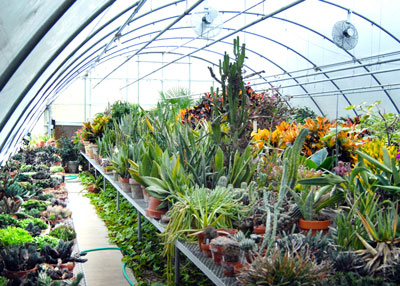
I’ve always loved succulents. I bought a used commercial greenhouse 35 years ago, and it’s been my hobby place ever since.
My dad and I built two home greenhouses while I was growing up. One was in my backyard garden when I was about 13. But we didn’t realize that poly plastic was only good for one year back then (cheap stuff still is) and it blew in with the first freezing north wind of its second winter.
So we built a second greenhouse attached to our garage. I could work out there while my dad worked in his shop. Those were some of my favorite memories of growing up in College Station.
I started out at Texas A&M, but the prof back then (mid-60s) didn’t let us do much in the greenhouses and I ended up transferring to Ohio State where the floriculture enrollment was 75 times larger – I was in with 340 other plant geeks, and it was terrific.
I started my Master’s program at Colorado State where I worked in carnation breeding – in a greenhouse. But Lynn and I got engaged, and I went back to Ohio to those old, familiar greenhouses.
Once I finished my Masters, we both taught in northern Ohio. I taught vocational horticulture in Shelby, Ohio, and we had two beautiful new greenhouses at Pioneer Joint Vocational High School. (Teaching those students was, by the way, the most rewarding job I’ve ever had. The students were identified as potential dropouts, and I saw their lives turn around before my eyes. Beautiful young men and women transformed into hard-working students with renewed self-esteem. It doesn’t get any better.)
But I’m way off target.
My initial point in all this was that I’ve had a greenhouse around me since I was barely a teenager, and I just can’t imagine life without one. I thought this might be a good time to share some of the tidbits and pointers I’ve learned over those years in the hopes that they might inspire you to get a greenhouse yourself.
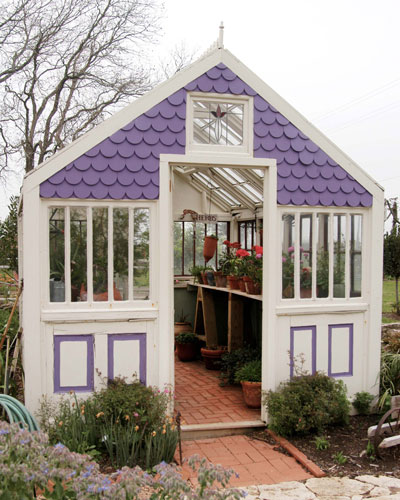
A small hobby greenhouse at the Antique Rose Emporium in Independence reflects back to an earlier era.
Greenhouse guidelines…
There are some basic things that are critical if you’re going to succeed with your new greenhouse endeavor. I’ll list them as bullets so we can cover a lot of ground in a hurry.
• Check your local HOA and building codes to make sure what you’re doing will pass all the ordinances.
• Go for morning sun and shade in the afternoon. You’ll be grateful for that shade come mid-summer.
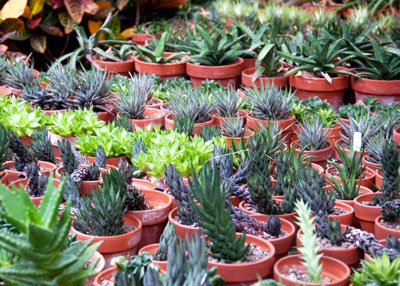
Haworthias can endure high temperatures in summer. I spent years collecting several hundred types.
• Build as large a greenhouse as your space and budget will allow. First reason: You’ll fill it up almost immediately. Second reason: larger greenhouses have greater volumes of air. They heat up and cool down more gradually, and that’s much better for your plants. I had a 10×20-ft. greenhouse at one point, and that was about as small as I would suggest.
• Glass is most attractive if the greenhouse will be a part of your backyard landscape. Double-layered and inflated polyethylene plastic is what most commercial growers use. Buy a UV-resistant type if you plan to leave it in place for two or three years. Other materials are also used, but be sure they hold up to the Texas sunlight for years on end.
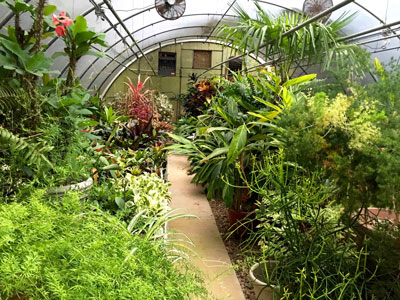
These plants are about to come out of the Sperry greenhouse to be used in our landscape in spring. If this greenhouse were visible from our house I probably wouldn’t have chosen this style.
• Windows and vents, where feasible, should be on the south walls to take advantage of prevailing winds in the summer. If you’re going to install an exhaust fan, blow the air out to the north. There’s no point in blowing into a south breeze. That largely defeats the purpose.
• Have a piece of nursery shade cloth fabricated to fit over your greenhouse. You can buy any density you want, from very light shading to dense, mushroom-house shading. I leave 62-percent shading on my greenhouse year-round. I would need more sunlight if I were growing more flowering plants. I had it bound and had grommets put into it, and I had it cut 15 percent larger than necessary to allow for shrinkage.
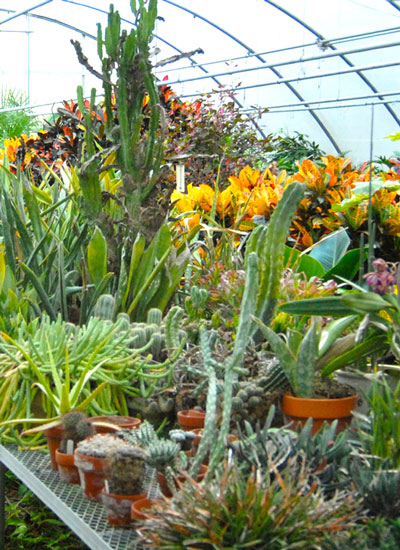
Benches have to be able to hold up considerable weight, including plants, clay pots and wet potting soil.
• Benches should be made of decay- and rust-resistant materials. Aluminum, pressure-treated wood and vinyl are all possibilities. If you’re reaching from one side, benches should be 36 inches wide. If from both sides, 48 to 54 inches wide. Be sure they’re supported to prevent sagging.
• Aisles should be wide enough for a wheelbarrow, but don’t waste a lot more space than that on them.
• I use large gravel beneath my benches. It keeps water from splashing all over your shoes and it helps hold humidity in the greenhouse between waterings. That helps the plants. I also grow devil’s ivy within that gravel just to soften the look. I can also use it for cuttings if I want to start more plants.
• If you have gas on your property, it will be an affordable means of heating the greenhouse. Be sure it’s vented, however, and if a blower is involved, have a back-up generator hooked in should the power go out.
• Very small greenhouses (6×8 feet, for example) can be heated with an electric space heater. Set it up off wet ground and be sure that it can’t tip over. Again, you’ll want an emergency back-up heat source in case of power outages.
• If you have a thermostat installed in your greenhouse, be sure it’s one that’s made for use in greenhouses, warehouses and barns – places with moisture and high humidity. I learned the hard way that condensation can short out a thermostat just when you need it the most.
As for sources of greenhouses, that’s a never-ending question. There are Texas-based companies that will build them for you. A quick Google search will turn up several. Plans are available online. Skilled carpenters can easily build them. (My dad and I even did!) Where there’s a will, there’s a greenhouse.
I hope you enjoy yours half as much as I’ve enjoyed mine over all these years!
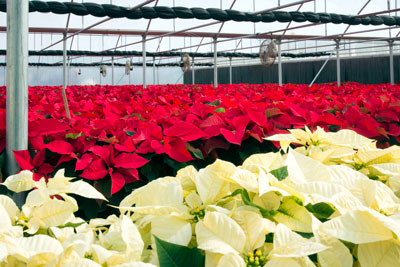
I’ve told my buddy Kenneth Cranfill, one of the best commercial growers I’ve ever known, that he is living my dream. This is what I expected to be doing – growing poinsettias and other greenhouse crops for a living. It just goes to show you how far afield our careers will take us. But I wouldn’t trade my experiences for anything. (However, I still envy Kenneth every time I set foot in his greenhouses!)
